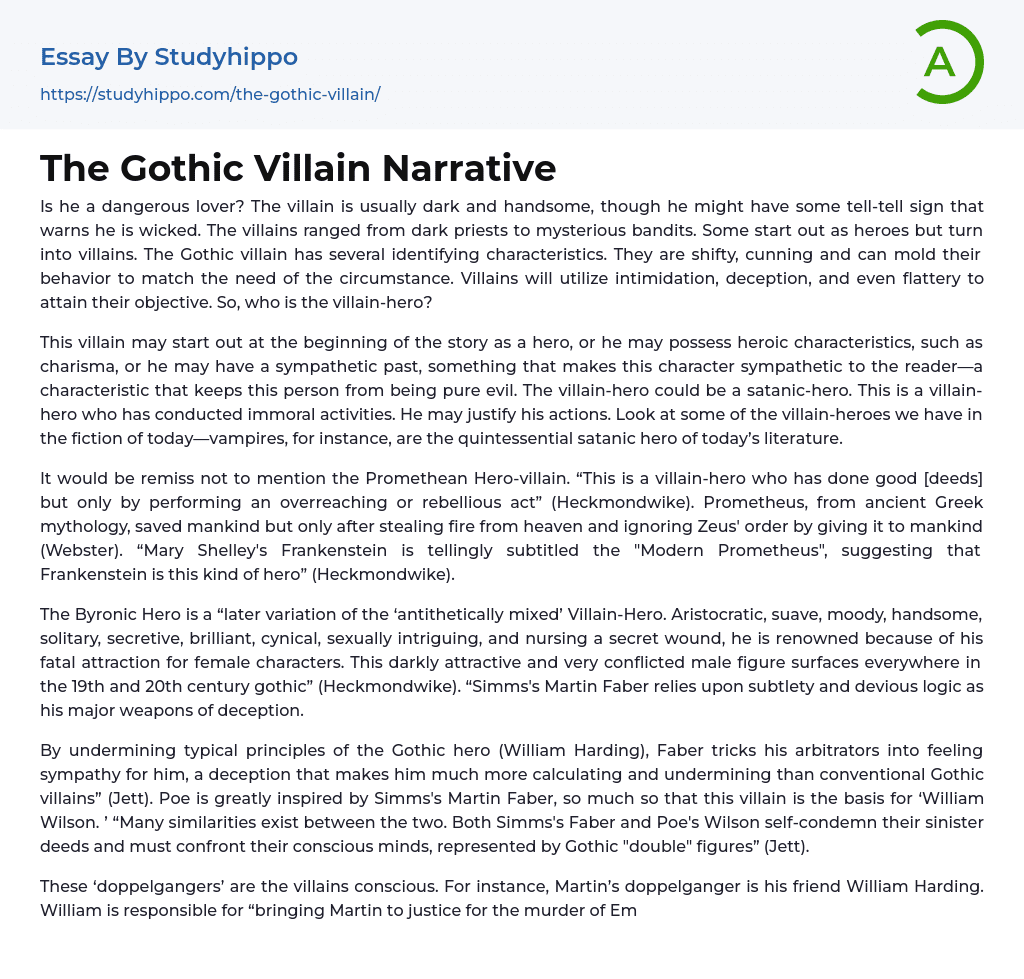Is he a dangerous lover? The villain is usually dark and handsome, though he might have some tell-tell sign that warns he is wicked. The villains ranged from dark priests to mysterious bandits. Some start out as heroes but turn into villains. The Gothic villain has several identifying characteristics. They are shifty, cunning and can mold their behavior to match the need of the circumstance. Villains will utilize intimidation, deception, and even flattery to attain their objective. So, who is the villain-hero?
This villain may start out at the beginning of the story as a hero, or he may possess heroic characteristics, such as charisma, or he may have a sympathetic past, something that makes this character sympathetic to the reader—a characteristic that keeps this person from being pure evil. The villain-hero could be a satanic-hero. This is a villain-hero who has conducted immoral activities. He
...may justify his actions. Look at some of the villain-heroes we have in the fiction of today—vampires, for instance, are the quintessential satanic hero of today’s literature.
It would be remiss not to mention the Promethean Hero-villain. “This is a villain-hero who has done good [deeds] but only by performing an overreaching or rebellious act” (Heckmondwike). Prometheus, from ancient Greek mythology, saved mankind but only after stealing fire from heaven and ignoring Zeus' order by giving it to mankind (Webster). “Mary Shelley's Frankenstein is tellingly subtitled the "Modern Prometheus", suggesting that Frankenstein is this kind of hero” (Heckmondwike).
The Byronic Hero is a “later variation of the ‘antithetically mixed’ Villain-Hero. Aristocratic, suave, moody, handsome, solitary, secretive, brilliant, cynical, sexually intriguing, and nursing a secret wound, he is renowned
because of his fatal attraction for female characters. This darkly attractive and very conflicted male figure surfaces everywhere in the 19th and 20th century gothic” (Heckmondwike). “Simms's Martin Faber relies upon subtlety and devious logic as his major weapons of deception.
By undermining typical principles of the Gothic hero (William Harding), Faber tricks his arbitrators into feeling sympathy for him, a deception that makes him much more calculating and undermining than conventional Gothic villains” (Jett). Poe is greatly inspired by Simms's Martin Faber, so much so that this villain is the basis for ‘William Wilson. ’ “Many similarities exist between the two. Both Simms's Faber and Poe's Wilson self-condemn their sinister deeds and must confront their conscious minds, represented by Gothic "double" figures” (Jett).
These ‘doppelgangers’ are the villains conscious. For instance, Martin’s doppelganger is his friend William Harding. William is responsible for “bringing Martin to justice for the murder of Emily Andrews” (Jett). Wilson's doppelganger is a schoolmate who has his same name and challenges him whenever he gives into his evil side. Their selfish needs motivate Faber and Wilson. “However, the major difference between the two centers on Wilson's inability to express guilt over his sins and Faber's perpetual need to confess his.
Consequently, Poe failed to establish a dynamic Gothic villain in William Wilson—one capable of demonstrating feigned remorse in multidimensional facets Wilson commits only trivial crimes, hardly comparable to Faber's crime of murder” (Jett). Many of Poe's villains take on the characteristics of the self-indulgent Aristocrat. Poe used this often mad, at times inventive, noble heir in place of the traditional Gothic villain. His villains depict the transcendent hostility of life
itself instead of the evil personified by individuals.
Some of the tales that Poe utilized the Aristocrat villain: “The Fall of the House of Usher,” such characters appear in his stories ‘Metzengerstein’ (1840), ‘Berenice’ (1840), ‘Ligeia’ (1838), ‘The Oval Portrait’ (1842), and ‘The Masque of the Red Death’ (1842)” (Poe). Poe had another villain; one that was not a typical gothic villain, this villain was the guilty conscious. These include ‘The Black Cat,’ ‘The Tell-Tale Heart,’ and the doppelganger story ‘William Wilson’ (1840).
In, ‘The Black Cat’ and “The Tell-Tale Heart,’ it is the villains guilty conscious that give away his deed—in both cases the deed is murder. In the Tell-Tale Heart, it is the still beating heart of the old man that gets louder and louder and louder. In ‘The Black Cat’ it is the screaming animal on his wife’s head that is his undoing. While the stories ‘The Pit and the Pendulum’ (1843), and ‘The Cask of Amontillado’ do not utilize a guilty conscience as their villain, “they [do] share the same paranoid intensity demonstrated in these tales” (Poe).
Sensationalizing controversy and fears, in the face of the quickly transforming social and economic environment, turn into the typical medium for gothic authors to engage in the aesthetic and political questions brought about by current events. The Gothic Villain personifies the evil the writers see in their society.
- Allegory essays
- Alliteration essays
- Comedy essays
- Comic book essays
- Drama essays
- Dystopia essays
- Fairy Tale essays
- Fantasy essays
- Fiction essays
- Ghost essays
- Gothic Fiction essays
- Gothic Literature essays
- Irony essays
- Legend essays
- Memoir essays
- Novel essays
- Poetry essays
- Satire essays
- Science Fiction essays
- Short Story essays
- The western essays
- Tragedy essays
- Witchcraft essays
- American Literature essays
- Between The World and Me essays
- Book Report essays
- Book Review essays
- Book Summary essays
- Books essays
- Character essays
- Coming of Age essays
- Dante's Inferno essays
- Everyday Use essays
- Flowers for Algernon essays
- Genre essays
- Greek Mythology essays
- Incidents in The Life of a Slave Girl essays
- Letter essays
- Literary Criticism essays
- Literary devices essays
- Literature Review essays
- Metaphor essays
- Myth essays
- Play essays
- Plot essays
- Poem essays
- Poetry Analysis essays
- Protagonist essays
- Reader essays
- Reason essays




